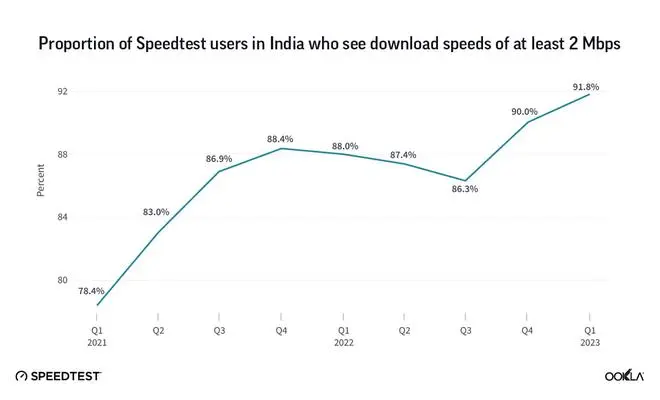While India’s 5G roll-out has ensured subscribers get faster internet speeds, the network upgrade could also be helping more subscribers cross the 2Mbps threshold of minimum mobile internet speeds.
A recent analysis by Ookla, the company whose app is used for testing internet speeds, found that the number of speed tests crossing the 2Mbps threshold have risen from 79 per cent in 2021 to 91.8 per cent in 2023.
A 2Mbps data connection is required to carry out all the common internet use cases, including browsing the internet, using social media and messaging applications, making one-on-one video calls, listening to music online, and watching TV in standard definition quality.
The Telecom Regulatory Authority of India has also laid down that a minimum threshold of 2Mbps for the broadband tag.
As of February 2023, the broadband tag requires telecom operators to offer a minimum speed of 2Mbps, up sharply from a fourth of that bandwidth, 512Kbps, required since 2013.

This change in regulation came after a nine-year battle between telecom operators and the government, where telcos sought a a more lax definition of broadband so that more of their connections could qualify for broadband status.
2Mbps speed available to most people
From Ookla’s data, it appears that almost all of India’s population enjoys a minimum speed of 2Mbps at all times (or almost all times). Recent reports, however, suggest that telecommunication grey spots still exist in the country, where access to basic Internet and connectivity services is still absent.
Interestingly, the deployment of 5G networks has played a major role in ensuring that 90 per cent of Ookla speed tests done in India cross the 2Mbps threshold.
Before the launch of 5G services, the proportion of tests that recorded a minimum speed of 2Mbps on mobile networks was on the decline.
However, with the October launch of 5G services, this number has been rising once again. This means that the overall quality of telecom networks in India has improved, irrespective of whether it is 4G or 5G.
Sylwia Kechiche, Principal Industry Analyst, Enterprise, at Ookla conjectures that Bharti Airtel and Reliance Jio are likely modernising their existing 4G networks when they visit network sites to deploy 5G radios.
An expert aware of the network deployment strategy of Bharti Airtel and Reliance Jio told businessline that in anticipation of the 5G launch, telcos also improved their backhaul capacities to improve the overall network quality.
They have not only switched backhaul from microwave spectrum to optic fibre, but also collaborated with service providers such as Netflix and Google, asking them to host their services on local servers — both these steps have had a positive effect on improving network speeds.
“Telcos are also gaming the Ookla speed tests,” the expert warned, “they maintain good quality network on the servers Ookla uses to test mobile internet speeds,” the expert said.
Overall, it appears that5G deployment is not only making internet speeds faster for those on the 5G network, but 5G and non-5G users alike now have easier access to faster and more usable mobile internet at all times.




Comments
Comments have to be in English, and in full sentences. They cannot be abusive or personal. Please abide by our community guidelines for posting your comments.
We have migrated to a new commenting platform. If you are already a registered user of TheHindu Businessline and logged in, you may continue to engage with our articles. If you do not have an account please register and login to post comments. Users can access their older comments by logging into their accounts on Vuukle.